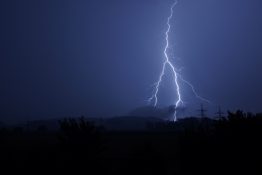Almost all of the world’s 31 largest carnivore species, including gray wolves, grizzly bears, cheetahs and lions, have been impacted by human development and activity. Most of these animals have seen their range and populations decline over the past century, and many are listed as threatened by international conservation groups. As conservationists and scientists consider if and how to bring back these species in significant numbers across their historical ranges, many potential conflicts arise: Will the animals pose a threat to humans or livestock?
Read more at UW News »Can artificial intelligence revolutionize weather forecasting?
In an age of rapidly advancing technology, humans are fascinated with AI, which is shorthand for artificial intelligence. Many movies and TV shows feature this techno-wizardry, whether it’s AI beings starring in our favorite Marvel movies or the creation of deeply imaginative worlds that depict post-apocalyptic robot takeovers. The idea of deep learning machines is one we often think about in fictional contexts, but at the University of Washington researchers are looking at practical, real-world applications.
Read more »Deforestation-fueled heat already affecting millions of outdoor workers in the tropics
Pledges made in Glasgow at the recent United Nations Climate Change Conference, or COP26, are urgently needed by communities on the front lines of forest loss, according to a new study by a multidisciplinary team from the University of Washington, Duke University and The Nature Conservancy. New research shows how much local temperature rises in the tropics — compounded by accelerating deforestation — may already be jeopardizing the well-being and productivity of outdoor workers.
Read more at UW News »Artificial intelligence can create better lightning forecasts
Lightning is one of the most destructive forces of nature, as in 2020 when it sparked the massive California Lightning Complex fires, but it remains hard to predict. A new study led by the University of Washington shows that machine learning — computer algorithms that improve themselves without direct programming by humans — can be used to improve lightning forecasts. Better lightning forecasts could help to prepare for potential wildfires, improve safety warnings for lightning and create more accurate long-range climate models.
Read more at UW News »Simulations show how earthquake early warning might be improved for magnitude-9 earthquakes
When the next major earthquake hits the Pacific Northwest, a system launched last spring should give some advance warning, as emergency alerts go out and cell phones buzz. But how well the system functions might depend on whether that quake is the so-called “really big one,” and where it starts. The Pacific Northwest’s last magnitude-9 event from the offshore subduction zone was in 1700.
Read more at UW News »





